Innovation Management: Analysis of Scope and Technology Transfer
VerifiedAdded on 2022/11/28
|15
|4050
|376
Report
AI Summary
This report, submitted by a student, delves into the critical aspects of innovation management, examining its significance in the modern business landscape. It explores the core concepts of innovation management, emphasizing the creation and implementation of creative ideas, and its role in achieving operational effectiveness and competitive advantage. The report analyzes the scope of innovation management, the importance of fostering a culture of innovation, and the role of technology transfer. The methodology employed involves an interpretivist approach, utilizing secondary data sources such as websites, academic journals, and articles to analyze the topic. The findings highlight the significance of innovation for companies like Apple and Samsung, which use innovation to gain acceptance and a competitive edge in the market. The report concludes with recommendations for fostering innovation and technology transfer within organizations. The report also includes discussion, findings, and recommendations related to the subject matter.
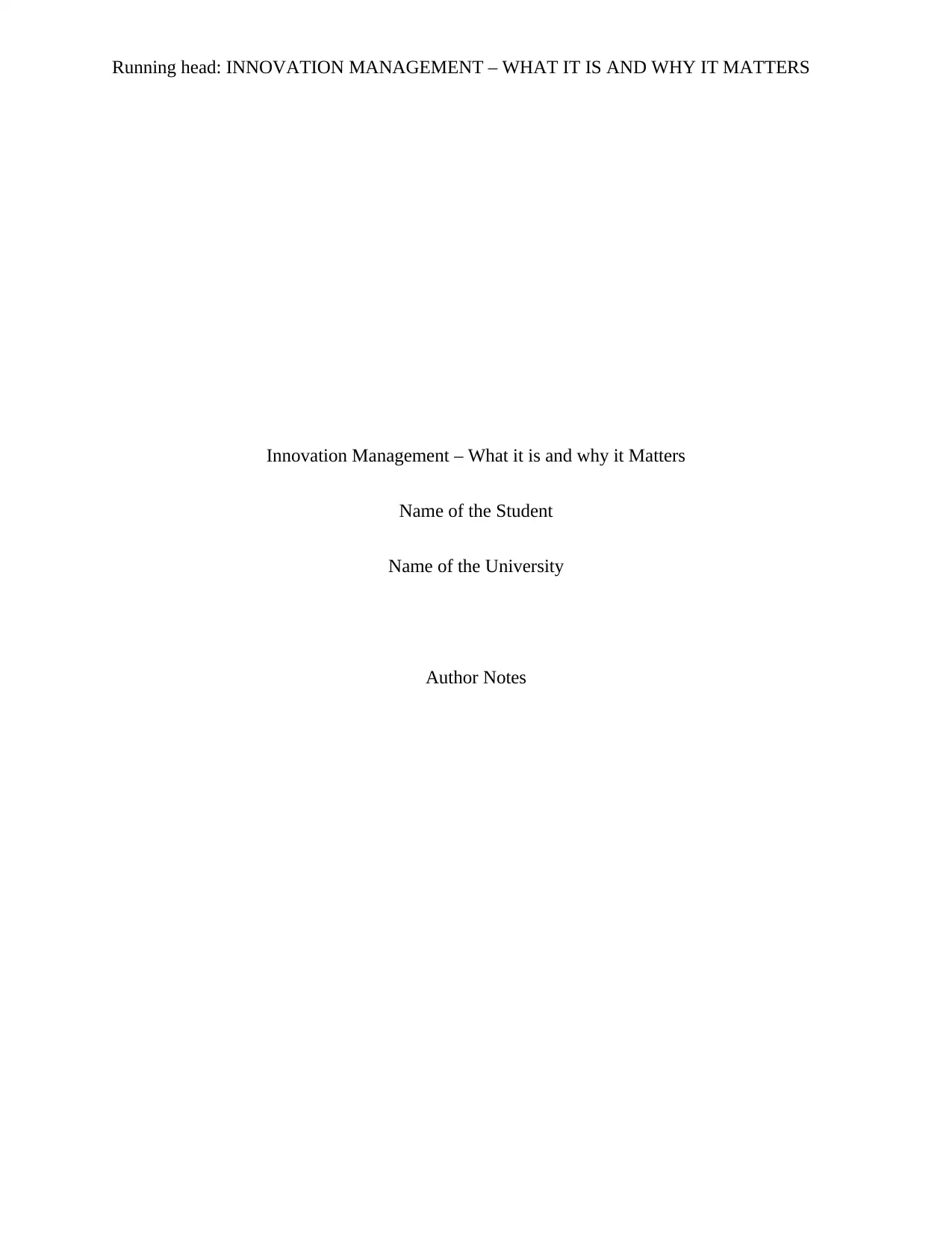
Running head: INNOVATION MANAGEMENT – WHAT IT IS AND WHY IT MATTERS
Innovation Management – What it is and why it Matters
Name of the Student
Name of the University
Author Notes
Innovation Management – What it is and why it Matters
Name of the Student
Name of the University
Author Notes
Paraphrase This Document
Need a fresh take? Get an instant paraphrase of this document with our AI Paraphraser
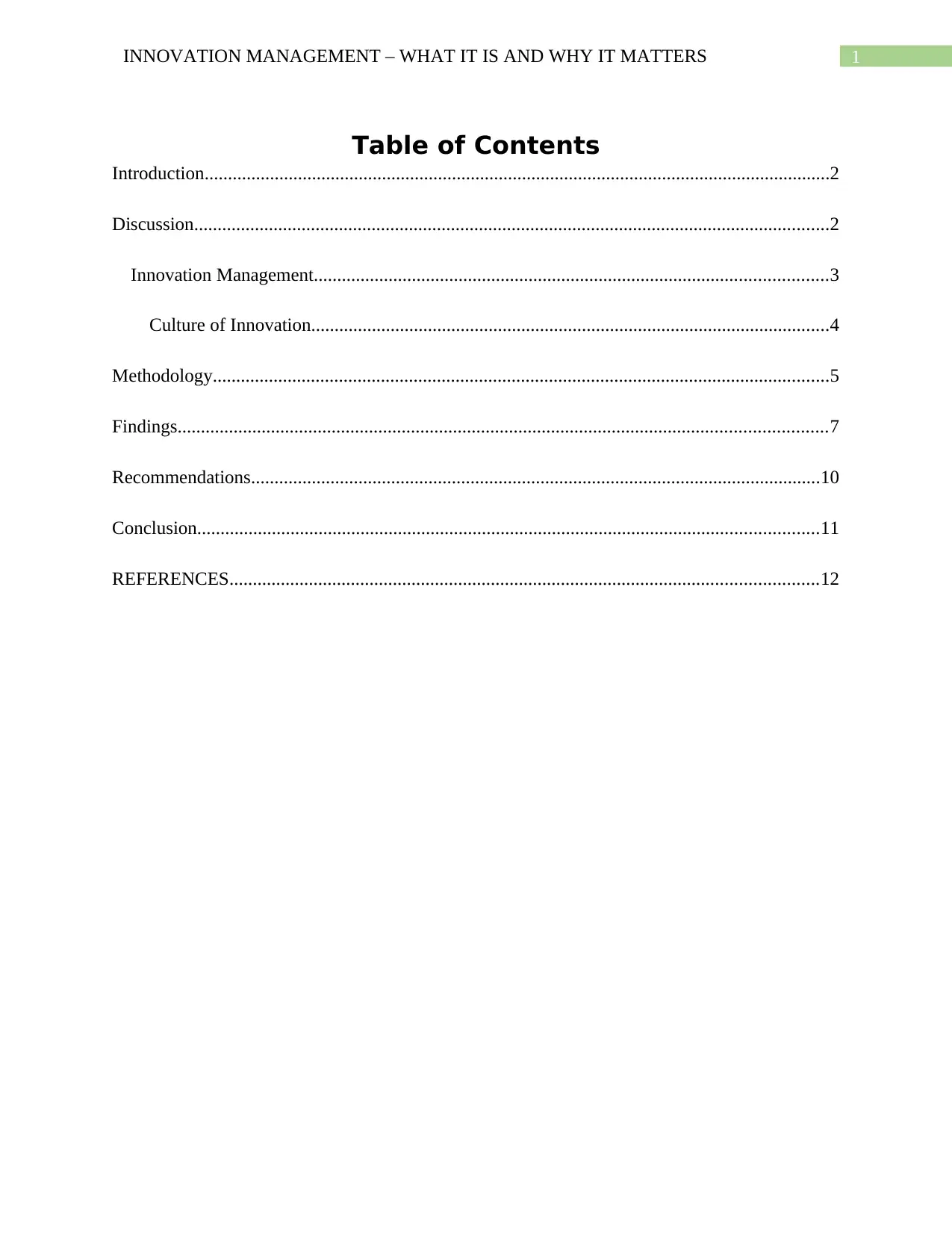
1INNOVATION MANAGEMENT – WHAT IT IS AND WHY IT MATTERS
Table of Contents
Introduction......................................................................................................................................2
Discussion........................................................................................................................................2
Innovation Management..............................................................................................................3
Culture of Innovation...............................................................................................................4
Methodology....................................................................................................................................5
Findings...........................................................................................................................................7
Recommendations..........................................................................................................................10
Conclusion.....................................................................................................................................11
REFERENCES..............................................................................................................................12
Table of Contents
Introduction......................................................................................................................................2
Discussion........................................................................................................................................2
Innovation Management..............................................................................................................3
Culture of Innovation...............................................................................................................4
Methodology....................................................................................................................................5
Findings...........................................................................................................................................7
Recommendations..........................................................................................................................10
Conclusion.....................................................................................................................................11
REFERENCES..............................................................................................................................12

2INNOVATION MANAGEMENT – WHAT IT IS AND WHY IT MATTERS
Introduction
The modern business environment is challenging and in order to gain favourable nature
of outcomes in operations, companies must incorporate strategies through which they are able to
gain favourable nature of outcomes while operating in the industry. There are various activities
that can be conducted by companies in order to gain effectiveness in operation while the part of a
dynamic and competitive business environment (Slack and Jones 2018). Apart from trying to
achieve operational effectiveness in all the functional departments of the companies they should
incorporate activities that help in elevating the standards of the activities of the functional
department (Calipari, Ferris and Jones 2014). Incorporation of favourable policies, including risk
management and innovation management are activities that can bolster the nature of operations
of companies (White 2017). The aim of the paper is to critically analyse the scope of innovation
management and technology transfer. The paper will also present the methodology of the
analytical approach that was obtained, finding regarding the general nature of operations that
take place on the industry linking the same with the commercial viability of the solution while
integrated theory with the same.
Discussion
It has been identified that there are various factors that companies need to highlight while
catering to the needs associated with the general nature of operations of the organisation,
regardless of the nature of operations of the company or the industry that the latter is operating
in. Thus, innovation management has been identified as an approach that helps in elevating the
level at which the company is performing (Frow et al. 2015). Moreover, innovation management
is an activity that must be incorporated into the operations of companies to identify the scope of
Introduction
The modern business environment is challenging and in order to gain favourable nature
of outcomes in operations, companies must incorporate strategies through which they are able to
gain favourable nature of outcomes while operating in the industry. There are various activities
that can be conducted by companies in order to gain effectiveness in operation while the part of a
dynamic and competitive business environment (Slack and Jones 2018). Apart from trying to
achieve operational effectiveness in all the functional departments of the companies they should
incorporate activities that help in elevating the standards of the activities of the functional
department (Calipari, Ferris and Jones 2014). Incorporation of favourable policies, including risk
management and innovation management are activities that can bolster the nature of operations
of companies (White 2017). The aim of the paper is to critically analyse the scope of innovation
management and technology transfer. The paper will also present the methodology of the
analytical approach that was obtained, finding regarding the general nature of operations that
take place on the industry linking the same with the commercial viability of the solution while
integrated theory with the same.
Discussion
It has been identified that there are various factors that companies need to highlight while
catering to the needs associated with the general nature of operations of the organisation,
regardless of the nature of operations of the company or the industry that the latter is operating
in. Thus, innovation management has been identified as an approach that helps in elevating the
level at which the company is performing (Frow et al. 2015). Moreover, innovation management
is an activity that must be incorporated into the operations of companies to identify the scope of
⊘ This is a preview!⊘
Do you want full access?
Subscribe today to unlock all pages.

Trusted by 1+ million students worldwide
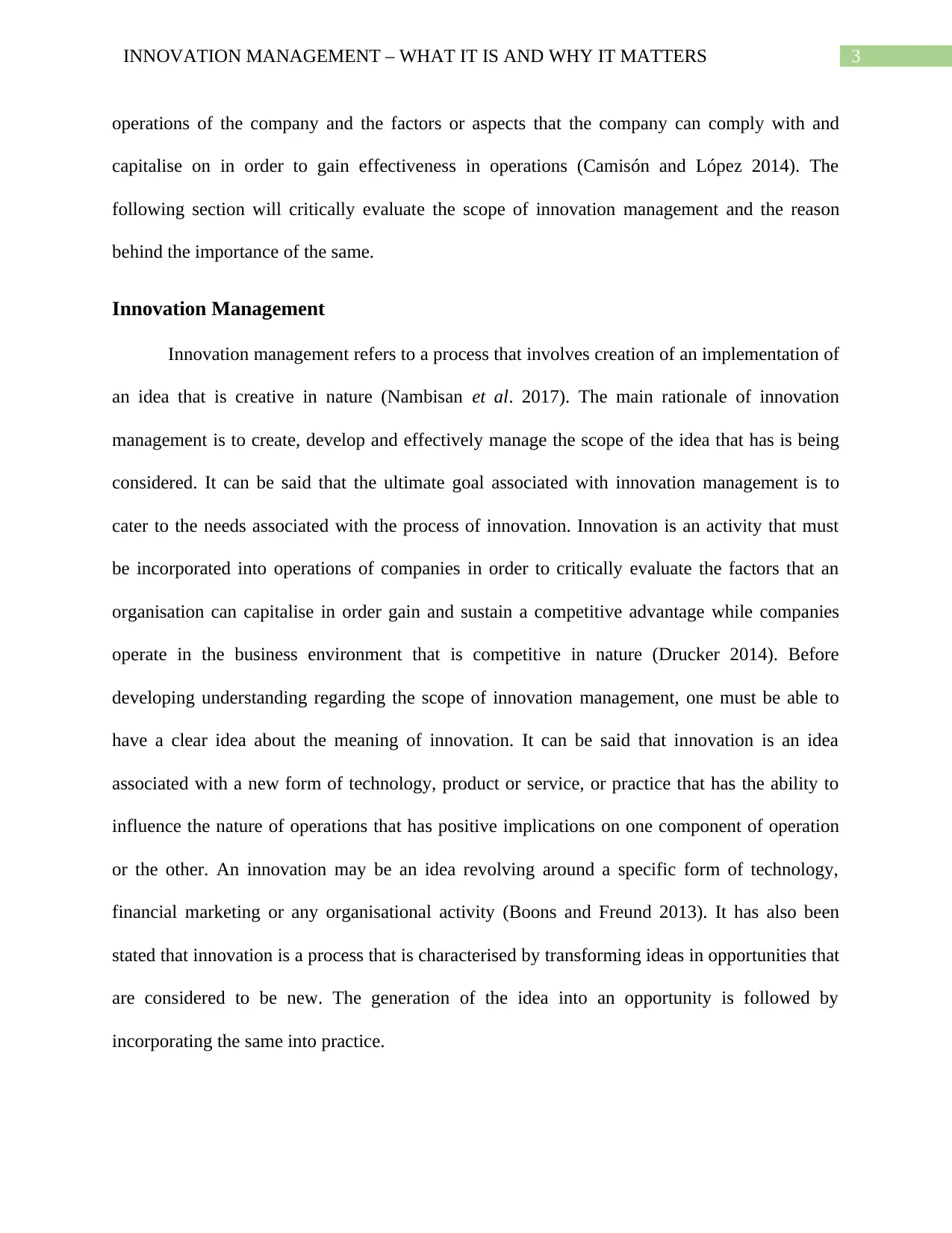
3INNOVATION MANAGEMENT – WHAT IT IS AND WHY IT MATTERS
operations of the company and the factors or aspects that the company can comply with and
capitalise on in order to gain effectiveness in operations (Camisón and López 2014). The
following section will critically evaluate the scope of innovation management and the reason
behind the importance of the same.
Innovation Management
Innovation management refers to a process that involves creation of an implementation of
an idea that is creative in nature (Nambisan et al. 2017). The main rationale of innovation
management is to create, develop and effectively manage the scope of the idea that has is being
considered. It can be said that the ultimate goal associated with innovation management is to
cater to the needs associated with the process of innovation. Innovation is an activity that must
be incorporated into operations of companies in order to critically evaluate the factors that an
organisation can capitalise in order gain and sustain a competitive advantage while companies
operate in the business environment that is competitive in nature (Drucker 2014). Before
developing understanding regarding the scope of innovation management, one must be able to
have a clear idea about the meaning of innovation. It can be said that innovation is an idea
associated with a new form of technology, product or service, or practice that has the ability to
influence the nature of operations that has positive implications on one component of operation
or the other. An innovation may be an idea revolving around a specific form of technology,
financial marketing or any organisational activity (Boons and Freund 2013). It has also been
stated that innovation is a process that is characterised by transforming ideas in opportunities that
are considered to be new. The generation of the idea into an opportunity is followed by
incorporating the same into practice.
operations of the company and the factors or aspects that the company can comply with and
capitalise on in order to gain effectiveness in operations (Camisón and López 2014). The
following section will critically evaluate the scope of innovation management and the reason
behind the importance of the same.
Innovation Management
Innovation management refers to a process that involves creation of an implementation of
an idea that is creative in nature (Nambisan et al. 2017). The main rationale of innovation
management is to create, develop and effectively manage the scope of the idea that has is being
considered. It can be said that the ultimate goal associated with innovation management is to
cater to the needs associated with the process of innovation. Innovation is an activity that must
be incorporated into operations of companies in order to critically evaluate the factors that an
organisation can capitalise in order gain and sustain a competitive advantage while companies
operate in the business environment that is competitive in nature (Drucker 2014). Before
developing understanding regarding the scope of innovation management, one must be able to
have a clear idea about the meaning of innovation. It can be said that innovation is an idea
associated with a new form of technology, product or service, or practice that has the ability to
influence the nature of operations that has positive implications on one component of operation
or the other. An innovation may be an idea revolving around a specific form of technology,
financial marketing or any organisational activity (Boons and Freund 2013). It has also been
stated that innovation is a process that is characterised by transforming ideas in opportunities that
are considered to be new. The generation of the idea into an opportunity is followed by
incorporating the same into practice.
Paraphrase This Document
Need a fresh take? Get an instant paraphrase of this document with our AI Paraphraser
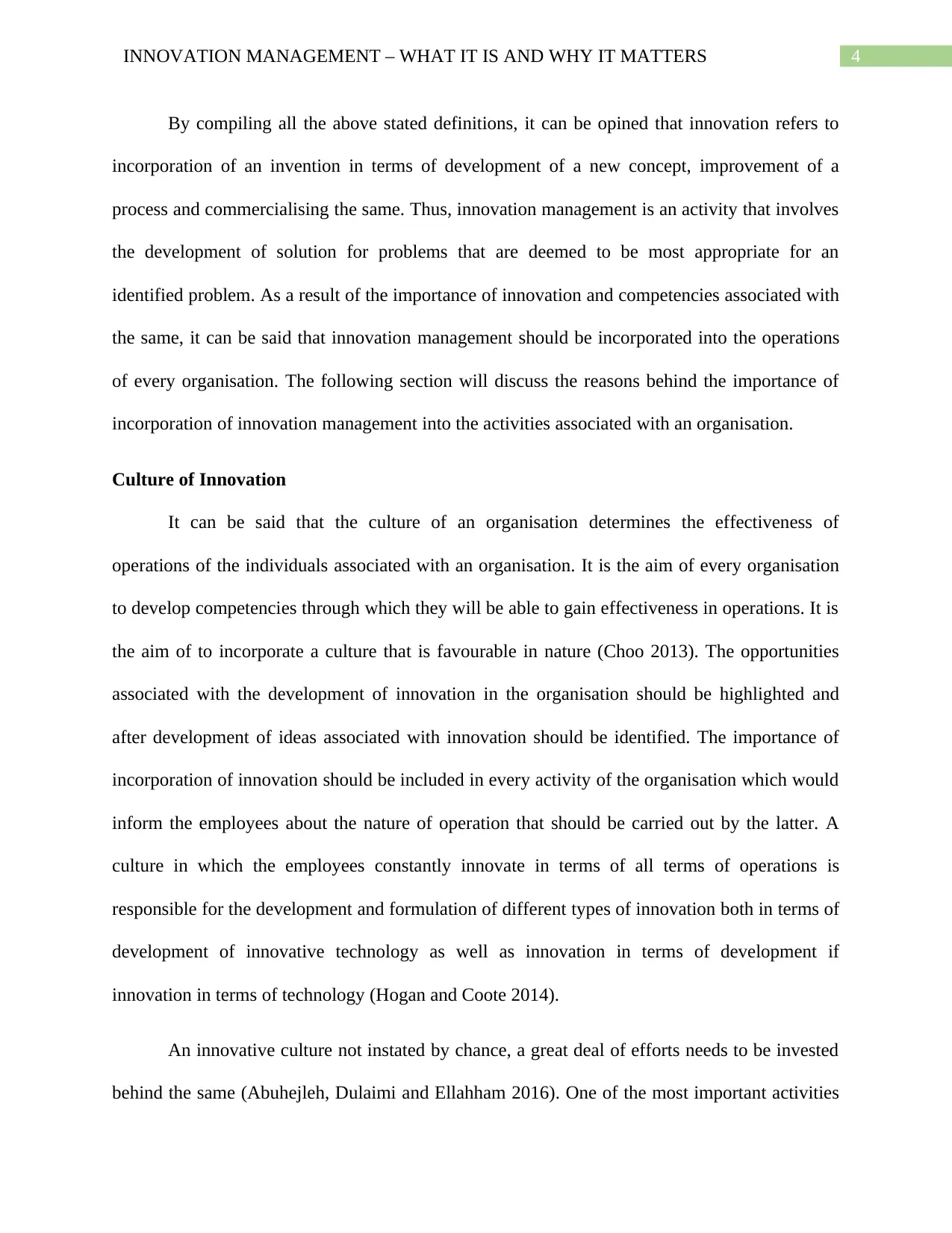
4INNOVATION MANAGEMENT – WHAT IT IS AND WHY IT MATTERS
By compiling all the above stated definitions, it can be opined that innovation refers to
incorporation of an invention in terms of development of a new concept, improvement of a
process and commercialising the same. Thus, innovation management is an activity that involves
the development of solution for problems that are deemed to be most appropriate for an
identified problem. As a result of the importance of innovation and competencies associated with
the same, it can be said that innovation management should be incorporated into the operations
of every organisation. The following section will discuss the reasons behind the importance of
incorporation of innovation management into the activities associated with an organisation.
Culture of Innovation
It can be said that the culture of an organisation determines the effectiveness of
operations of the individuals associated with an organisation. It is the aim of every organisation
to develop competencies through which they will be able to gain effectiveness in operations. It is
the aim of to incorporate a culture that is favourable in nature (Choo 2013). The opportunities
associated with the development of innovation in the organisation should be highlighted and
after development of ideas associated with innovation should be identified. The importance of
incorporation of innovation should be included in every activity of the organisation which would
inform the employees about the nature of operation that should be carried out by the latter. A
culture in which the employees constantly innovate in terms of all terms of operations is
responsible for the development and formulation of different types of innovation both in terms of
development of innovative technology as well as innovation in terms of development if
innovation in terms of technology (Hogan and Coote 2014).
An innovative culture not instated by chance, a great deal of efforts needs to be invested
behind the same (Abuhejleh, Dulaimi and Ellahham 2016). One of the most important activities
By compiling all the above stated definitions, it can be opined that innovation refers to
incorporation of an invention in terms of development of a new concept, improvement of a
process and commercialising the same. Thus, innovation management is an activity that involves
the development of solution for problems that are deemed to be most appropriate for an
identified problem. As a result of the importance of innovation and competencies associated with
the same, it can be said that innovation management should be incorporated into the operations
of every organisation. The following section will discuss the reasons behind the importance of
incorporation of innovation management into the activities associated with an organisation.
Culture of Innovation
It can be said that the culture of an organisation determines the effectiveness of
operations of the individuals associated with an organisation. It is the aim of every organisation
to develop competencies through which they will be able to gain effectiveness in operations. It is
the aim of to incorporate a culture that is favourable in nature (Choo 2013). The opportunities
associated with the development of innovation in the organisation should be highlighted and
after development of ideas associated with innovation should be identified. The importance of
incorporation of innovation should be included in every activity of the organisation which would
inform the employees about the nature of operation that should be carried out by the latter. A
culture in which the employees constantly innovate in terms of all terms of operations is
responsible for the development and formulation of different types of innovation both in terms of
development of innovative technology as well as innovation in terms of development if
innovation in terms of technology (Hogan and Coote 2014).
An innovative culture not instated by chance, a great deal of efforts needs to be invested
behind the same (Abuhejleh, Dulaimi and Ellahham 2016). One of the most important activities
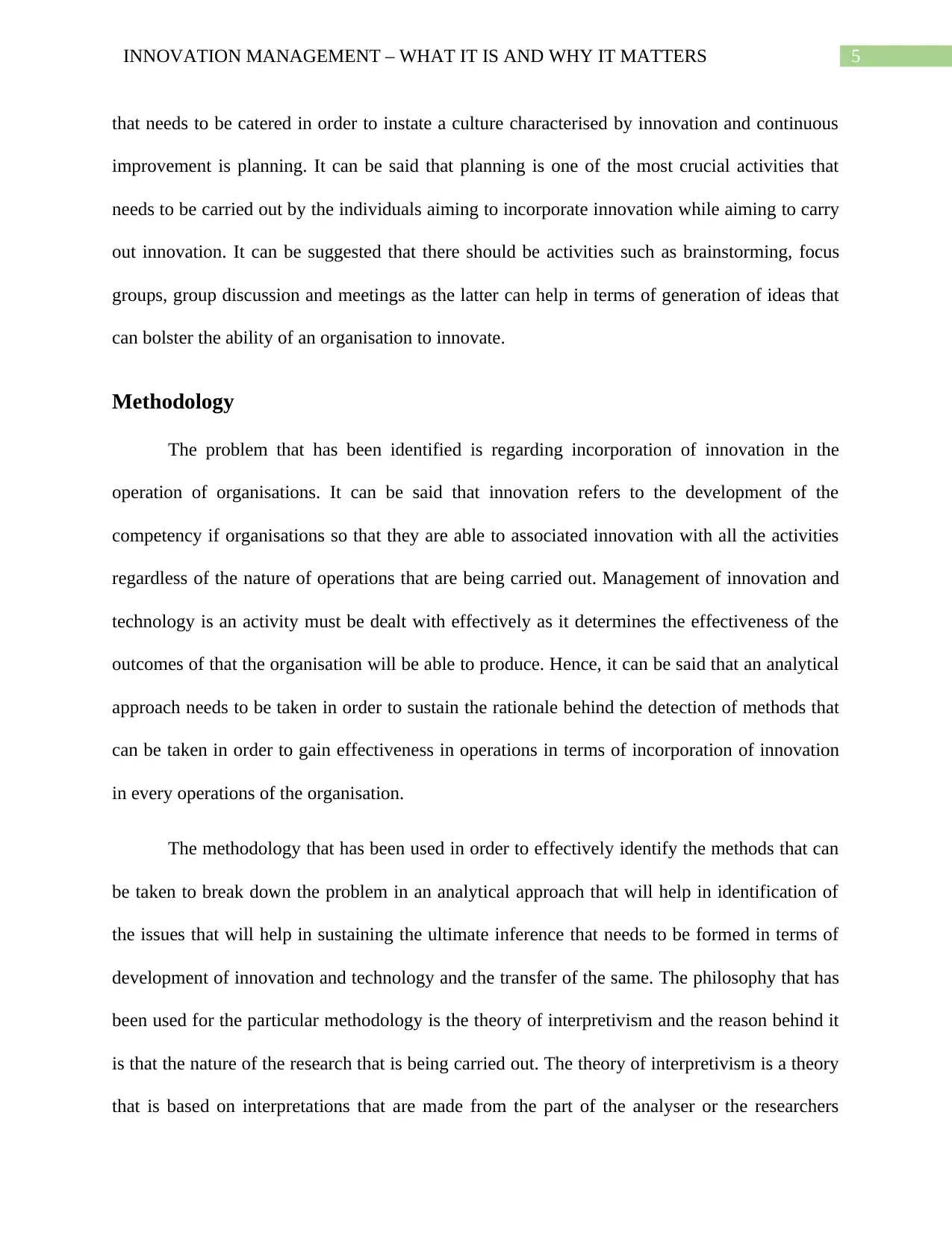
5INNOVATION MANAGEMENT – WHAT IT IS AND WHY IT MATTERS
that needs to be catered in order to instate a culture characterised by innovation and continuous
improvement is planning. It can be said that planning is one of the most crucial activities that
needs to be carried out by the individuals aiming to incorporate innovation while aiming to carry
out innovation. It can be suggested that there should be activities such as brainstorming, focus
groups, group discussion and meetings as the latter can help in terms of generation of ideas that
can bolster the ability of an organisation to innovate.
Methodology
The problem that has been identified is regarding incorporation of innovation in the
operation of organisations. It can be said that innovation refers to the development of the
competency if organisations so that they are able to associated innovation with all the activities
regardless of the nature of operations that are being carried out. Management of innovation and
technology is an activity must be dealt with effectively as it determines the effectiveness of the
outcomes of that the organisation will be able to produce. Hence, it can be said that an analytical
approach needs to be taken in order to sustain the rationale behind the detection of methods that
can be taken in order to gain effectiveness in operations in terms of incorporation of innovation
in every operations of the organisation.
The methodology that has been used in order to effectively identify the methods that can
be taken to break down the problem in an analytical approach that will help in identification of
the issues that will help in sustaining the ultimate inference that needs to be formed in terms of
development of innovation and technology and the transfer of the same. The philosophy that has
been used for the particular methodology is the theory of interpretivism and the reason behind it
is that the nature of the research that is being carried out. The theory of interpretivism is a theory
that is based on interpretations that are made from the part of the analyser or the researchers
that needs to be catered in order to instate a culture characterised by innovation and continuous
improvement is planning. It can be said that planning is one of the most crucial activities that
needs to be carried out by the individuals aiming to incorporate innovation while aiming to carry
out innovation. It can be suggested that there should be activities such as brainstorming, focus
groups, group discussion and meetings as the latter can help in terms of generation of ideas that
can bolster the ability of an organisation to innovate.
Methodology
The problem that has been identified is regarding incorporation of innovation in the
operation of organisations. It can be said that innovation refers to the development of the
competency if organisations so that they are able to associated innovation with all the activities
regardless of the nature of operations that are being carried out. Management of innovation and
technology is an activity must be dealt with effectively as it determines the effectiveness of the
outcomes of that the organisation will be able to produce. Hence, it can be said that an analytical
approach needs to be taken in order to sustain the rationale behind the detection of methods that
can be taken in order to gain effectiveness in operations in terms of incorporation of innovation
in every operations of the organisation.
The methodology that has been used in order to effectively identify the methods that can
be taken to break down the problem in an analytical approach that will help in identification of
the issues that will help in sustaining the ultimate inference that needs to be formed in terms of
development of innovation and technology and the transfer of the same. The philosophy that has
been used for the particular methodology is the theory of interpretivism and the reason behind it
is that the nature of the research that is being carried out. The theory of interpretivism is a theory
that is based on interpretations that are made from the part of the analyser or the researchers
⊘ This is a preview!⊘
Do you want full access?
Subscribe today to unlock all pages.

Trusted by 1+ million students worldwide
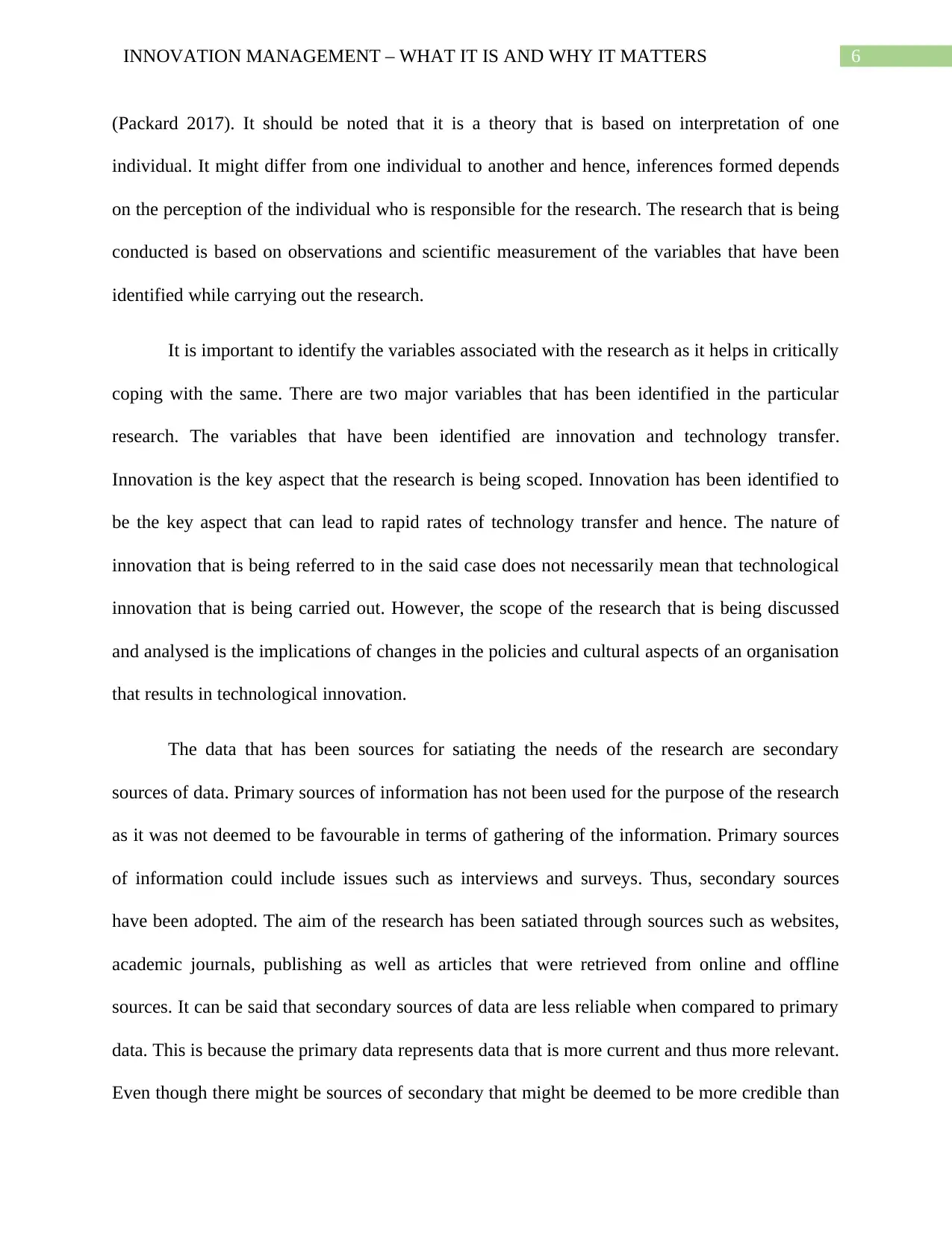
6INNOVATION MANAGEMENT – WHAT IT IS AND WHY IT MATTERS
(Packard 2017). It should be noted that it is a theory that is based on interpretation of one
individual. It might differ from one individual to another and hence, inferences formed depends
on the perception of the individual who is responsible for the research. The research that is being
conducted is based on observations and scientific measurement of the variables that have been
identified while carrying out the research.
It is important to identify the variables associated with the research as it helps in critically
coping with the same. There are two major variables that has been identified in the particular
research. The variables that have been identified are innovation and technology transfer.
Innovation is the key aspect that the research is being scoped. Innovation has been identified to
be the key aspect that can lead to rapid rates of technology transfer and hence. The nature of
innovation that is being referred to in the said case does not necessarily mean that technological
innovation that is being carried out. However, the scope of the research that is being discussed
and analysed is the implications of changes in the policies and cultural aspects of an organisation
that results in technological innovation.
The data that has been sources for satiating the needs of the research are secondary
sources of data. Primary sources of information has not been used for the purpose of the research
as it was not deemed to be favourable in terms of gathering of the information. Primary sources
of information could include issues such as interviews and surveys. Thus, secondary sources
have been adopted. The aim of the research has been satiated through sources such as websites,
academic journals, publishing as well as articles that were retrieved from online and offline
sources. It can be said that secondary sources of data are less reliable when compared to primary
data. This is because the primary data represents data that is more current and thus more relevant.
Even though there might be sources of secondary that might be deemed to be more credible than
(Packard 2017). It should be noted that it is a theory that is based on interpretation of one
individual. It might differ from one individual to another and hence, inferences formed depends
on the perception of the individual who is responsible for the research. The research that is being
conducted is based on observations and scientific measurement of the variables that have been
identified while carrying out the research.
It is important to identify the variables associated with the research as it helps in critically
coping with the same. There are two major variables that has been identified in the particular
research. The variables that have been identified are innovation and technology transfer.
Innovation is the key aspect that the research is being scoped. Innovation has been identified to
be the key aspect that can lead to rapid rates of technology transfer and hence. The nature of
innovation that is being referred to in the said case does not necessarily mean that technological
innovation that is being carried out. However, the scope of the research that is being discussed
and analysed is the implications of changes in the policies and cultural aspects of an organisation
that results in technological innovation.
The data that has been sources for satiating the needs of the research are secondary
sources of data. Primary sources of information has not been used for the purpose of the research
as it was not deemed to be favourable in terms of gathering of the information. Primary sources
of information could include issues such as interviews and surveys. Thus, secondary sources
have been adopted. The aim of the research has been satiated through sources such as websites,
academic journals, publishing as well as articles that were retrieved from online and offline
sources. It can be said that secondary sources of data are less reliable when compared to primary
data. This is because the primary data represents data that is more current and thus more relevant.
Even though there might be sources of secondary that might be deemed to be more credible than
Paraphrase This Document
Need a fresh take? Get an instant paraphrase of this document with our AI Paraphraser
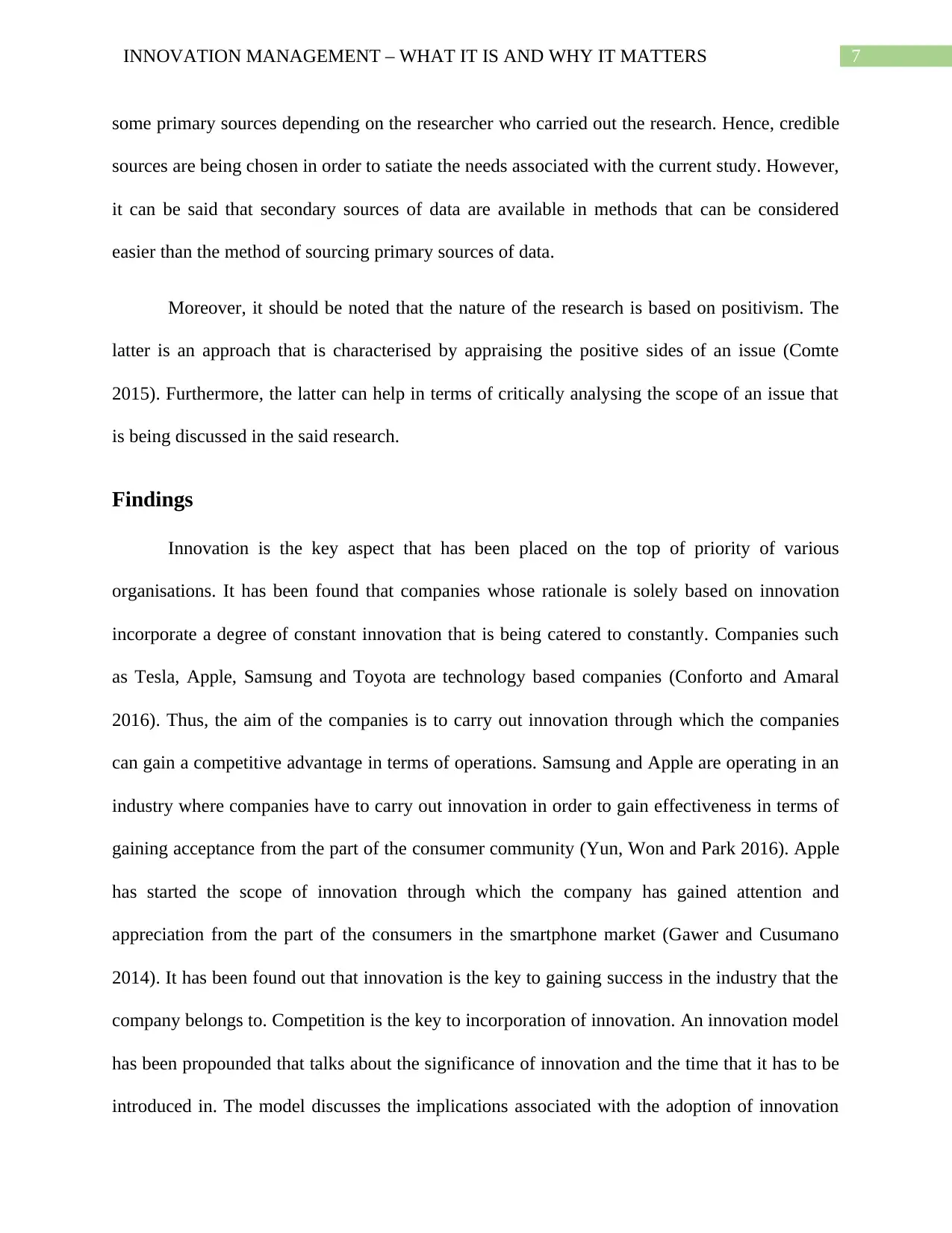
7INNOVATION MANAGEMENT – WHAT IT IS AND WHY IT MATTERS
some primary sources depending on the researcher who carried out the research. Hence, credible
sources are being chosen in order to satiate the needs associated with the current study. However,
it can be said that secondary sources of data are available in methods that can be considered
easier than the method of sourcing primary sources of data.
Moreover, it should be noted that the nature of the research is based on positivism. The
latter is an approach that is characterised by appraising the positive sides of an issue (Comte
2015). Furthermore, the latter can help in terms of critically analysing the scope of an issue that
is being discussed in the said research.
Findings
Innovation is the key aspect that has been placed on the top of priority of various
organisations. It has been found that companies whose rationale is solely based on innovation
incorporate a degree of constant innovation that is being catered to constantly. Companies such
as Tesla, Apple, Samsung and Toyota are technology based companies (Conforto and Amaral
2016). Thus, the aim of the companies is to carry out innovation through which the companies
can gain a competitive advantage in terms of operations. Samsung and Apple are operating in an
industry where companies have to carry out innovation in order to gain effectiveness in terms of
gaining acceptance from the part of the consumer community (Yun, Won and Park 2016). Apple
has started the scope of innovation through which the company has gained attention and
appreciation from the part of the consumers in the smartphone market (Gawer and Cusumano
2014). It has been found out that innovation is the key to gaining success in the industry that the
company belongs to. Competition is the key to incorporation of innovation. An innovation model
has been propounded that talks about the significance of innovation and the time that it has to be
introduced in. The model discusses the implications associated with the adoption of innovation
some primary sources depending on the researcher who carried out the research. Hence, credible
sources are being chosen in order to satiate the needs associated with the current study. However,
it can be said that secondary sources of data are available in methods that can be considered
easier than the method of sourcing primary sources of data.
Moreover, it should be noted that the nature of the research is based on positivism. The
latter is an approach that is characterised by appraising the positive sides of an issue (Comte
2015). Furthermore, the latter can help in terms of critically analysing the scope of an issue that
is being discussed in the said research.
Findings
Innovation is the key aspect that has been placed on the top of priority of various
organisations. It has been found that companies whose rationale is solely based on innovation
incorporate a degree of constant innovation that is being catered to constantly. Companies such
as Tesla, Apple, Samsung and Toyota are technology based companies (Conforto and Amaral
2016). Thus, the aim of the companies is to carry out innovation through which the companies
can gain a competitive advantage in terms of operations. Samsung and Apple are operating in an
industry where companies have to carry out innovation in order to gain effectiveness in terms of
gaining acceptance from the part of the consumer community (Yun, Won and Park 2016). Apple
has started the scope of innovation through which the company has gained attention and
appreciation from the part of the consumers in the smartphone market (Gawer and Cusumano
2014). It has been found out that innovation is the key to gaining success in the industry that the
company belongs to. Competition is the key to incorporation of innovation. An innovation model
has been propounded that talks about the significance of innovation and the time that it has to be
introduced in. The model discusses the implications associated with the adoption of innovation
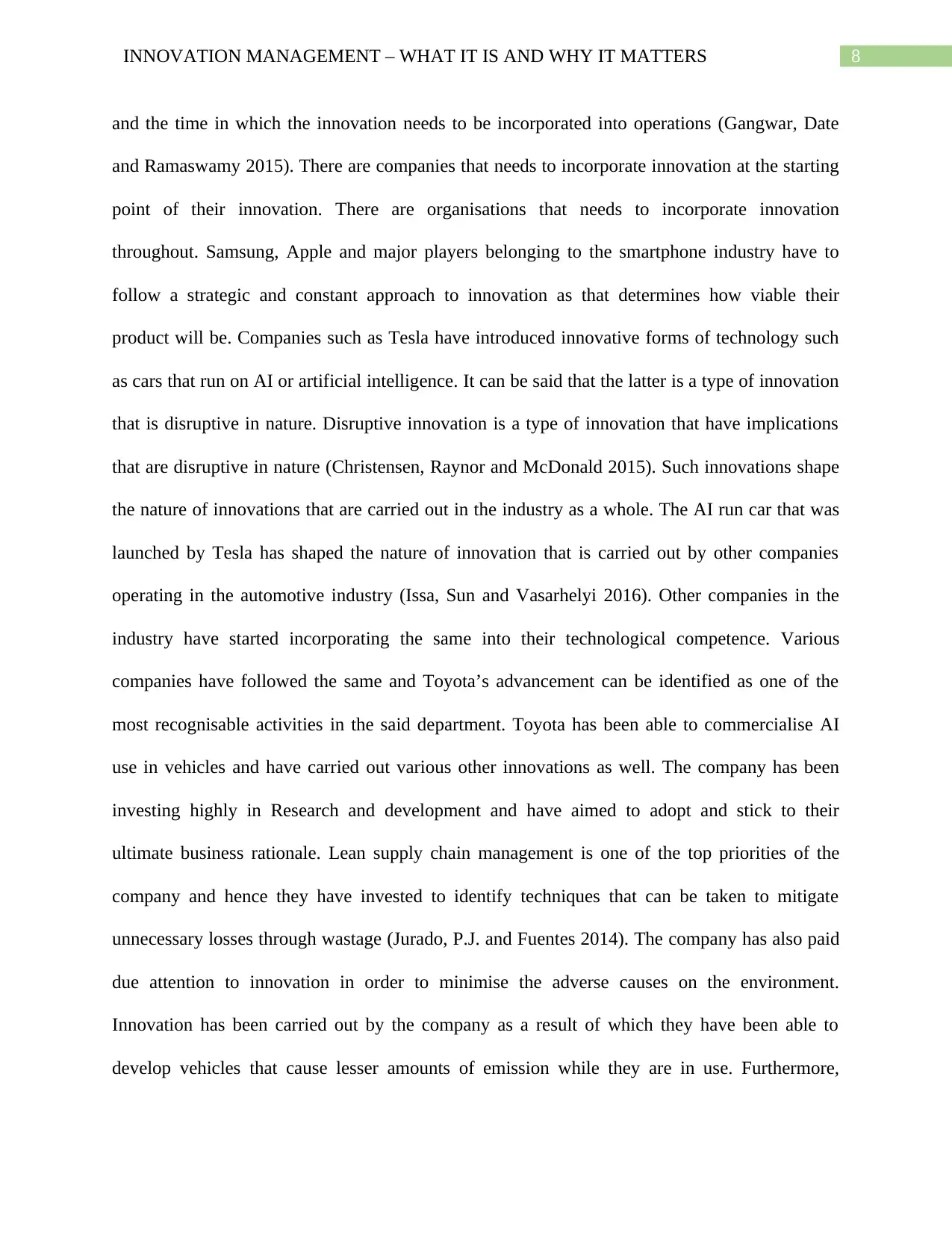
8INNOVATION MANAGEMENT – WHAT IT IS AND WHY IT MATTERS
and the time in which the innovation needs to be incorporated into operations (Gangwar, Date
and Ramaswamy 2015). There are companies that needs to incorporate innovation at the starting
point of their innovation. There are organisations that needs to incorporate innovation
throughout. Samsung, Apple and major players belonging to the smartphone industry have to
follow a strategic and constant approach to innovation as that determines how viable their
product will be. Companies such as Tesla have introduced innovative forms of technology such
as cars that run on AI or artificial intelligence. It can be said that the latter is a type of innovation
that is disruptive in nature. Disruptive innovation is a type of innovation that have implications
that are disruptive in nature (Christensen, Raynor and McDonald 2015). Such innovations shape
the nature of innovations that are carried out in the industry as a whole. The AI run car that was
launched by Tesla has shaped the nature of innovation that is carried out by other companies
operating in the automotive industry (Issa, Sun and Vasarhelyi 2016). Other companies in the
industry have started incorporating the same into their technological competence. Various
companies have followed the same and Toyota’s advancement can be identified as one of the
most recognisable activities in the said department. Toyota has been able to commercialise AI
use in vehicles and have carried out various other innovations as well. The company has been
investing highly in Research and development and have aimed to adopt and stick to their
ultimate business rationale. Lean supply chain management is one of the top priorities of the
company and hence they have invested to identify techniques that can be taken to mitigate
unnecessary losses through wastage (Jurado, P.J. and Fuentes 2014). The company has also paid
due attention to innovation in order to minimise the adverse causes on the environment.
Innovation has been carried out by the company as a result of which they have been able to
develop vehicles that cause lesser amounts of emission while they are in use. Furthermore,
and the time in which the innovation needs to be incorporated into operations (Gangwar, Date
and Ramaswamy 2015). There are companies that needs to incorporate innovation at the starting
point of their innovation. There are organisations that needs to incorporate innovation
throughout. Samsung, Apple and major players belonging to the smartphone industry have to
follow a strategic and constant approach to innovation as that determines how viable their
product will be. Companies such as Tesla have introduced innovative forms of technology such
as cars that run on AI or artificial intelligence. It can be said that the latter is a type of innovation
that is disruptive in nature. Disruptive innovation is a type of innovation that have implications
that are disruptive in nature (Christensen, Raynor and McDonald 2015). Such innovations shape
the nature of innovations that are carried out in the industry as a whole. The AI run car that was
launched by Tesla has shaped the nature of innovation that is carried out by other companies
operating in the automotive industry (Issa, Sun and Vasarhelyi 2016). Other companies in the
industry have started incorporating the same into their technological competence. Various
companies have followed the same and Toyota’s advancement can be identified as one of the
most recognisable activities in the said department. Toyota has been able to commercialise AI
use in vehicles and have carried out various other innovations as well. The company has been
investing highly in Research and development and have aimed to adopt and stick to their
ultimate business rationale. Lean supply chain management is one of the top priorities of the
company and hence they have invested to identify techniques that can be taken to mitigate
unnecessary losses through wastage (Jurado, P.J. and Fuentes 2014). The company has also paid
due attention to innovation in order to minimise the adverse causes on the environment.
Innovation has been carried out by the company as a result of which they have been able to
develop vehicles that cause lesser amounts of emission while they are in use. Furthermore,
⊘ This is a preview!⊘
Do you want full access?
Subscribe today to unlock all pages.

Trusted by 1+ million students worldwide
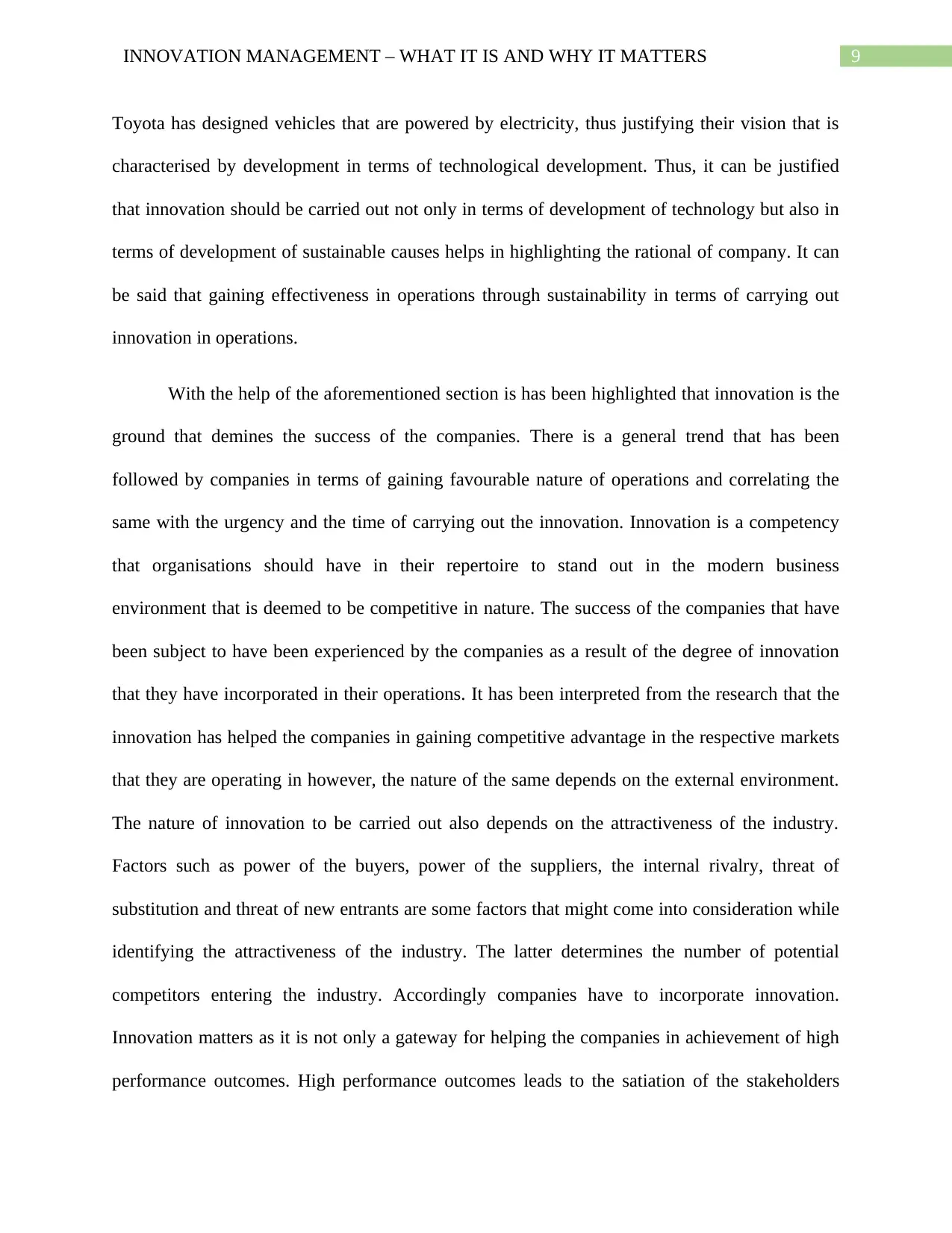
9INNOVATION MANAGEMENT – WHAT IT IS AND WHY IT MATTERS
Toyota has designed vehicles that are powered by electricity, thus justifying their vision that is
characterised by development in terms of technological development. Thus, it can be justified
that innovation should be carried out not only in terms of development of technology but also in
terms of development of sustainable causes helps in highlighting the rational of company. It can
be said that gaining effectiveness in operations through sustainability in terms of carrying out
innovation in operations.
With the help of the aforementioned section is has been highlighted that innovation is the
ground that demines the success of the companies. There is a general trend that has been
followed by companies in terms of gaining favourable nature of operations and correlating the
same with the urgency and the time of carrying out the innovation. Innovation is a competency
that organisations should have in their repertoire to stand out in the modern business
environment that is deemed to be competitive in nature. The success of the companies that have
been subject to have been experienced by the companies as a result of the degree of innovation
that they have incorporated in their operations. It has been interpreted from the research that the
innovation has helped the companies in gaining competitive advantage in the respective markets
that they are operating in however, the nature of the same depends on the external environment.
The nature of innovation to be carried out also depends on the attractiveness of the industry.
Factors such as power of the buyers, power of the suppliers, the internal rivalry, threat of
substitution and threat of new entrants are some factors that might come into consideration while
identifying the attractiveness of the industry. The latter determines the number of potential
competitors entering the industry. Accordingly companies have to incorporate innovation.
Innovation matters as it is not only a gateway for helping the companies in achievement of high
performance outcomes. High performance outcomes leads to the satiation of the stakeholders
Toyota has designed vehicles that are powered by electricity, thus justifying their vision that is
characterised by development in terms of technological development. Thus, it can be justified
that innovation should be carried out not only in terms of development of technology but also in
terms of development of sustainable causes helps in highlighting the rational of company. It can
be said that gaining effectiveness in operations through sustainability in terms of carrying out
innovation in operations.
With the help of the aforementioned section is has been highlighted that innovation is the
ground that demines the success of the companies. There is a general trend that has been
followed by companies in terms of gaining favourable nature of operations and correlating the
same with the urgency and the time of carrying out the innovation. Innovation is a competency
that organisations should have in their repertoire to stand out in the modern business
environment that is deemed to be competitive in nature. The success of the companies that have
been subject to have been experienced by the companies as a result of the degree of innovation
that they have incorporated in their operations. It has been interpreted from the research that the
innovation has helped the companies in gaining competitive advantage in the respective markets
that they are operating in however, the nature of the same depends on the external environment.
The nature of innovation to be carried out also depends on the attractiveness of the industry.
Factors such as power of the buyers, power of the suppliers, the internal rivalry, threat of
substitution and threat of new entrants are some factors that might come into consideration while
identifying the attractiveness of the industry. The latter determines the number of potential
competitors entering the industry. Accordingly companies have to incorporate innovation.
Innovation matters as it is not only a gateway for helping the companies in achievement of high
performance outcomes. High performance outcomes leads to the satiation of the stakeholders
Paraphrase This Document
Need a fresh take? Get an instant paraphrase of this document with our AI Paraphraser
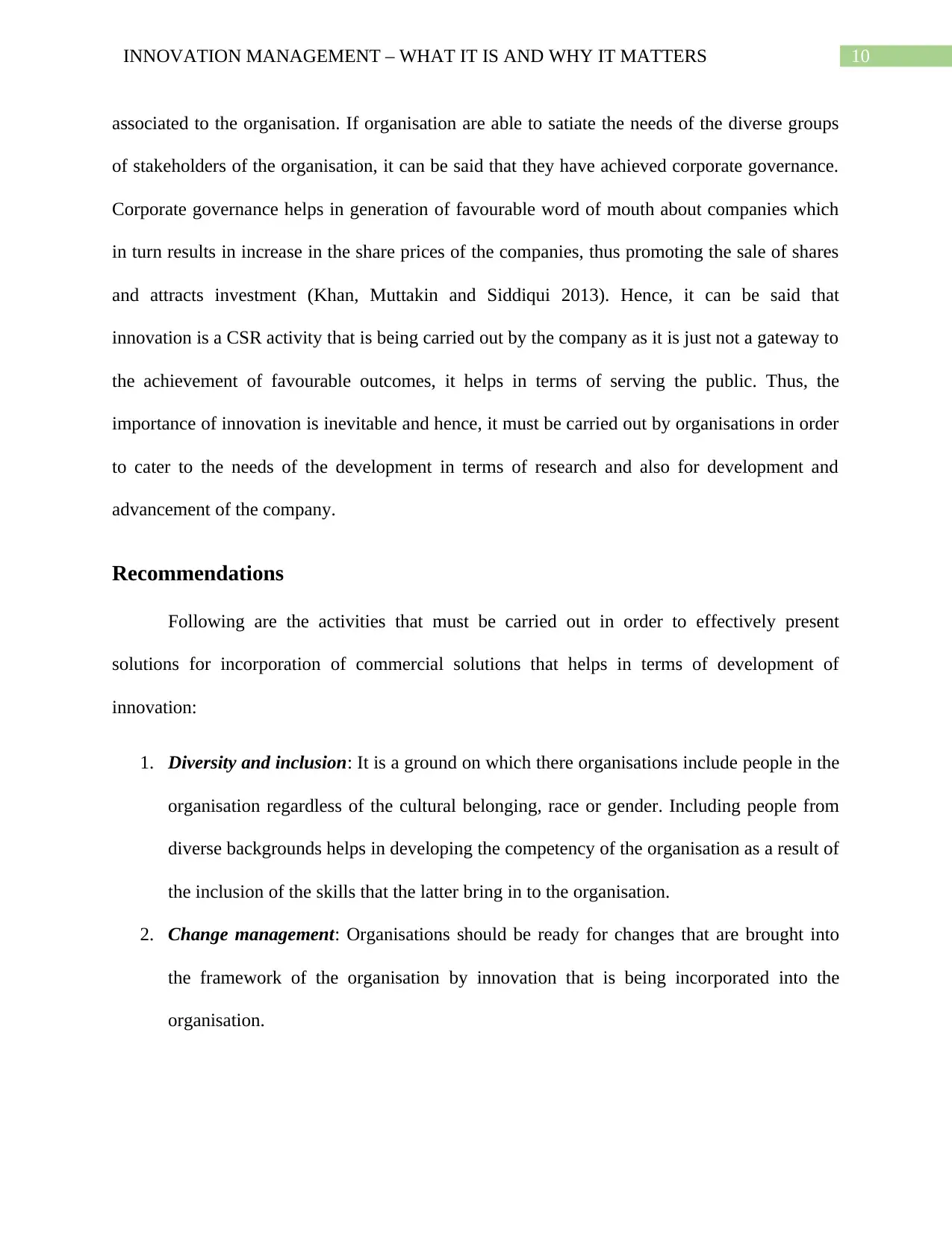
10INNOVATION MANAGEMENT – WHAT IT IS AND WHY IT MATTERS
associated to the organisation. If organisation are able to satiate the needs of the diverse groups
of stakeholders of the organisation, it can be said that they have achieved corporate governance.
Corporate governance helps in generation of favourable word of mouth about companies which
in turn results in increase in the share prices of the companies, thus promoting the sale of shares
and attracts investment (Khan, Muttakin and Siddiqui 2013). Hence, it can be said that
innovation is a CSR activity that is being carried out by the company as it is just not a gateway to
the achievement of favourable outcomes, it helps in terms of serving the public. Thus, the
importance of innovation is inevitable and hence, it must be carried out by organisations in order
to cater to the needs of the development in terms of research and also for development and
advancement of the company.
Recommendations
Following are the activities that must be carried out in order to effectively present
solutions for incorporation of commercial solutions that helps in terms of development of
innovation:
1. Diversity and inclusion: It is a ground on which there organisations include people in the
organisation regardless of the cultural belonging, race or gender. Including people from
diverse backgrounds helps in developing the competency of the organisation as a result of
the inclusion of the skills that the latter bring in to the organisation.
2. Change management: Organisations should be ready for changes that are brought into
the framework of the organisation by innovation that is being incorporated into the
organisation.
associated to the organisation. If organisation are able to satiate the needs of the diverse groups
of stakeholders of the organisation, it can be said that they have achieved corporate governance.
Corporate governance helps in generation of favourable word of mouth about companies which
in turn results in increase in the share prices of the companies, thus promoting the sale of shares
and attracts investment (Khan, Muttakin and Siddiqui 2013). Hence, it can be said that
innovation is a CSR activity that is being carried out by the company as it is just not a gateway to
the achievement of favourable outcomes, it helps in terms of serving the public. Thus, the
importance of innovation is inevitable and hence, it must be carried out by organisations in order
to cater to the needs of the development in terms of research and also for development and
advancement of the company.
Recommendations
Following are the activities that must be carried out in order to effectively present
solutions for incorporation of commercial solutions that helps in terms of development of
innovation:
1. Diversity and inclusion: It is a ground on which there organisations include people in the
organisation regardless of the cultural belonging, race or gender. Including people from
diverse backgrounds helps in developing the competency of the organisation as a result of
the inclusion of the skills that the latter bring in to the organisation.
2. Change management: Organisations should be ready for changes that are brought into
the framework of the organisation by innovation that is being incorporated into the
organisation.
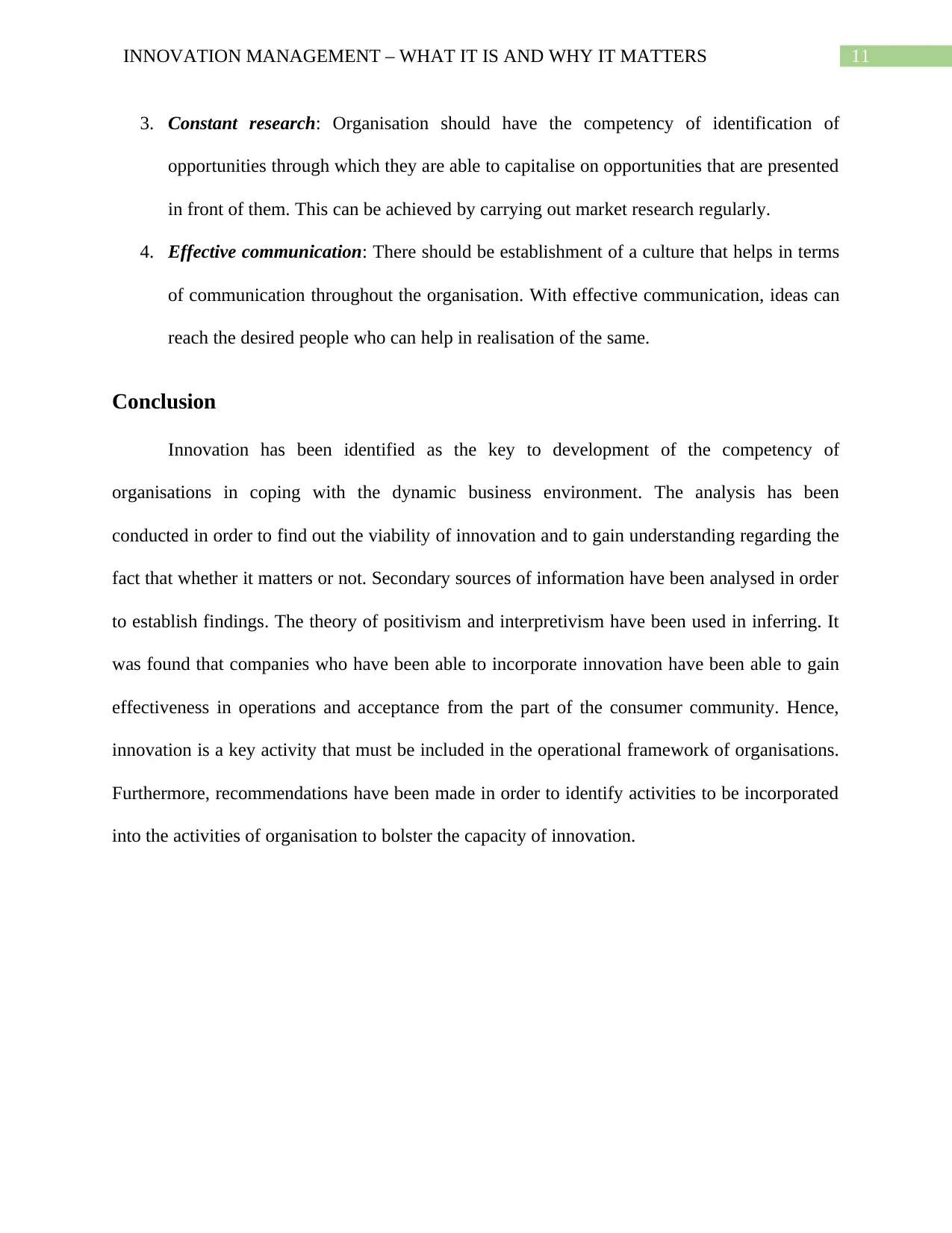
11INNOVATION MANAGEMENT – WHAT IT IS AND WHY IT MATTERS
3. Constant research: Organisation should have the competency of identification of
opportunities through which they are able to capitalise on opportunities that are presented
in front of them. This can be achieved by carrying out market research regularly.
4. Effective communication: There should be establishment of a culture that helps in terms
of communication throughout the organisation. With effective communication, ideas can
reach the desired people who can help in realisation of the same.
Conclusion
Innovation has been identified as the key to development of the competency of
organisations in coping with the dynamic business environment. The analysis has been
conducted in order to find out the viability of innovation and to gain understanding regarding the
fact that whether it matters or not. Secondary sources of information have been analysed in order
to establish findings. The theory of positivism and interpretivism have been used in inferring. It
was found that companies who have been able to incorporate innovation have been able to gain
effectiveness in operations and acceptance from the part of the consumer community. Hence,
innovation is a key activity that must be included in the operational framework of organisations.
Furthermore, recommendations have been made in order to identify activities to be incorporated
into the activities of organisation to bolster the capacity of innovation.
3. Constant research: Organisation should have the competency of identification of
opportunities through which they are able to capitalise on opportunities that are presented
in front of them. This can be achieved by carrying out market research regularly.
4. Effective communication: There should be establishment of a culture that helps in terms
of communication throughout the organisation. With effective communication, ideas can
reach the desired people who can help in realisation of the same.
Conclusion
Innovation has been identified as the key to development of the competency of
organisations in coping with the dynamic business environment. The analysis has been
conducted in order to find out the viability of innovation and to gain understanding regarding the
fact that whether it matters or not. Secondary sources of information have been analysed in order
to establish findings. The theory of positivism and interpretivism have been used in inferring. It
was found that companies who have been able to incorporate innovation have been able to gain
effectiveness in operations and acceptance from the part of the consumer community. Hence,
innovation is a key activity that must be included in the operational framework of organisations.
Furthermore, recommendations have been made in order to identify activities to be incorporated
into the activities of organisation to bolster the capacity of innovation.
⊘ This is a preview!⊘
Do you want full access?
Subscribe today to unlock all pages.

Trusted by 1+ million students worldwide
1 out of 15
Related Documents
Your All-in-One AI-Powered Toolkit for Academic Success.
+13062052269
info@desklib.com
Available 24*7 on WhatsApp / Email
![[object Object]](/_next/static/media/star-bottom.7253800d.svg)
Unlock your academic potential
Copyright © 2020–2025 A2Z Services. All Rights Reserved. Developed and managed by ZUCOL.





